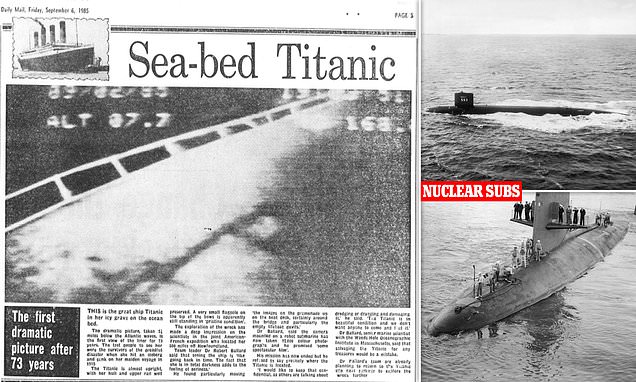The grainy image of the Titanic that captivated the world 70 years after it sank: How doomed liner was found at the bottom of the Atlantic during Cold War race against the Russians to find two missing US nuclear subs
- Ship was discovered by team led by Robert Ballard in September 1985
- Struck a deal with the US Navy to first look for USS Thresher and USS Scorpion
- READ MORE: Claustrophobic conditions inside Titanic vessel as air supply begins to run out
It was an image which captivated the world.
In September 1985 the ship was seen by the public for the first time in 73 years after being found by a team led by US Navy officer Robert Ballard.
The photo, which was published in the Daily Mail and elsewhere, was taken two and a half miles below the Atlantic waves, more than seven decades after the ship hit an iceberg on its maiden voyage and sank with the loss of more than 1,500 lives.
Ballard’s discovery, on September 1, was made all the more remarkable with his revelation in 2008 that the mission was actually a cover story to allow the US Navy to find the wrecks of two nuclear submarines during the Cold War.
After finding USS Thresher and USS Scorpion – which were lost during the 1960s with more than 200 men on board – Ballard was given just 12 days to look for the Titanic. If luck had not been on his side, he might never have found the wreck at all.
It was an image which captivated the world. In September 1985 the ship was seen by the public for the first time in 73 years after being found by a team led by US Navy officer Robert Ballard. The photo, which was published in the Daily Mail and elsewhere, was taken two and a half miles below the Atlantic waves
Since the Titanic slipped beneath the freezing waves of the Atlantic in April 1912, the the stricken ship has been an object of fascination for millions, Above: The Titanic embarking on its maiden voyage from Southampton
Speaking shortly after the wreck was discovered, Ballard said the ship was like ‘going back in time. The fact that she is in total darkness adds to the feeling of eeriness.’
Three years before the discovery, Ballard was a naval intelligence officer and oceanographer, working on developing his own remote control underwater vehicle.
CLICK TO READ MORE: The curse of the Titanic: How stricken ship has been jinxed ever since it was built – from its doomed maiden voyage to its eventual discovery 70 years later, controversial attempts to salvage the wreck… and now tourist visits
Running out of money, Ballard initially approached Navy bosses for funding to help find the Titanic.
That was when officials asked him to first find the submarines, one of which they feared may have been sunk by the Soviet Union.
‘I couldn’t tell anybody,’ the oceanographer said in 2008.
‘There was a lot of pressure on me. It was a secret mission. I felt it was a fair exchange for getting a chance to look for the Titanic.’
He added: ‘We handed the data to the experts. They never told us what they concluded – our job was to collect the data. I can only talk about it now because it has been declassified.’
Because of the need for secrecy, Ballard said how he suggested that the team ‘tell the world’ that they were looking for the Titanic.
USS Thresher (SSN-593) was the lead ship of her class of nuclear-powered attack submarines.
She was lost in 1963 during deep-sea diving tests after a high-pressure pipe burst, causing the vessel to lose power and implode as it sank.
The USS Scorpion disappeared in 1968 amid speculation that it was sunk by Soviet forces.
Ballard’s discovery was made all the more remarkable with his revelation in 2008 that the mission was actually a cover story to allow the US Navy to find the wrecks of two nuclear submarines during the Cold War
Nuclear-powered submarine the ‘USS Thresher’ steers through the sea, early 1960s. The sub sank in April of 1963, killing the entire crew
Officers and crew members of the ‘USS Scorpion’ stand on deck as the submarine arrives in Portsmouth, England, May 10, 1960. The vessel disappeared in 1968
Dr Ballard mapped both submarine wrecks using his newly developed underwater robot craft.
He concluded that the most likely cause of the Scorpion’s destruction was being hit by a rogue torpedo it had fired itself.
Investigating the wrecks gave Dr Ballard the idea of finding a trail of debris that would lead him to the Titanic.
Both the Thresher and Scorpion had both broken into thousands of pieces.
He criss-crossed the North Atlantic seabed and eventually found a debris trail leading him to the luxury liner’s final resting-place.
Speaking in 2018, Ballard said: ‘I learned something from mapping the Scorpion that taught me how to find the Titanic: look for its trail of debris.’
At the time she entered service, the Titanic was the largest ship in the world. She was the second of three Olympic-class liners operated by the White Star Line. Pictured: The ship being pulled out of Belfast harbour during sea trials
It took him eight days to find the ship. In the four days he had left, Ballard filmed the wreck.
He said that his team’s mood changed quickly as it got closer to the wreckage site.
‘We realized we were dancing on someone’s grave, and we were embarrassed,’ Ballard said.
‘The mood, it was like someone took a wall switch and went click.
‘And we became sober, calm, respectful, and we made a promise to never take anything from that ship, and to treat it with great respect.
‘You don’t go to Gettysburg with a shovel. You don’t take belt buckles off the Arizona.’
Source: Read Full Article






